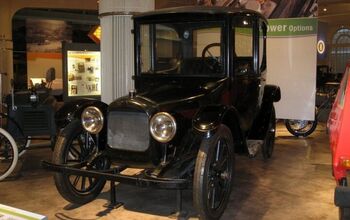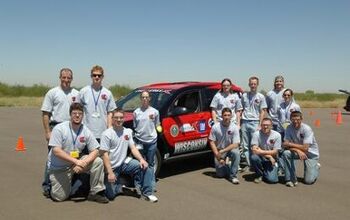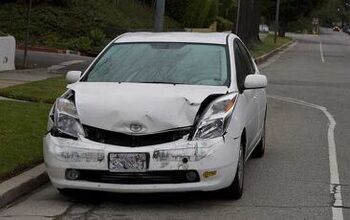Editorial: Hybrid Theory
Three years ago yesterday, on a Jalopnik-TTAC joint podcast, a certain Robert Farago foresaw the rise of a “hybrid aesthetic” in automotive design. In order to break into the consumer psyche, went his logic, a hybrid car must look unmistakably like . . . a hybrid. Fast forward to 2009 and the new Honda Insight seems to confirm that looking like a hybrid means looking like a Toyota Prius. Chevy’s Volt might someday become the third member of the Prian party, while the forthcoming Lexus HS250h looks to be a Prius rebadge of GM-level laziness. If hybrids are the cars of the future, are we doomed to inherit a world of identical, beetle-shaped rides?
The obvious explanation for Prian design influence run amok is found in the wind tunnel. The outgoing Prius boasted a low-low coefficient of drag (Cd) of .26, making for one slippery hybrid. But the current Mercedes S-Class and Lexus LS460 also earn the exact same rating. For a four-door, the Prius’s CdA (Cd multiplied by area) is also surprisingly good at 6.24. But that’s not much better than, say, a 1991 Subaru Legacy which scores a 6.81.
The point is that the pursuit of wind tunnel efficiency does not lead inexorably to the Prian form, like some aerodynamic Mandelbrot set. There’s more to the wave of Prius-aping than mere laws of nature. The hybrid, writ large, has entered the American psyche. And it looks just like a certain Toyota.
To many Americans, the outgoing Prius was more than just a car. Through eight years of George Bush’s presidency, the Prius became symbolic statement of iconic power. It would not be unfair to say that, in 21st Century American iconography, the Prius took on the role of the Volkswagen Beetle to Bush’s Richard Nixon. It’s distinctive looks, unsullied by visual association with humdrum “regular cars,” created an undeniable statement. The bumper sticker had wagged the car.
The always-incisive cartoon South Park tapped into the Prian archetype in its send-up of self-satisfied hybrid drivers, “ Smug Alert!.” The episode portrays the “Pious” and “Hindsight” as near-identical Prius-alikes, a subtle metaphor for the lockstep conformity of their “enlightened” owners. And with Honda’s latest hybrid so sincerely flattering the Prius’s looks, the South Park critique clearly had some merit.
But the real threat presented by the Priusification of the hybrid sector is not a looming cloud of smug. Rather, the very soul of automotive expression could become a victim of trend-following. Mass-market automotive offerings have long lost any stylistic luster, but more profitable “dedicated hybrid” models offer new opportunities to shape the automotive zeitgeist. In the face of this opportunity, automotive stylists seem to have raised the white flag, surrendering to (and thereby reinforcing) the power of the Prian archetype.
And this doesn’t just hasten the dystopic day when car buyers are forced to choose between a few flavors of hump-backed hybrid. Chasing the Prius’s self-defined segment too closely forces a comparison of the pretender to the original in which the newcomer may not fare well. The new Insight seems to have already fallen victim to this vicious dynamic. With so little separating the driving experiences of the Toyota and the Honda, reviewers are forced to conclude that the Insight is a slightly cheaper Prius without usable back seats.
Beyond this model-specific self-sabotage, the pursuit of the “dedicated hybrid” segment creates other dangerous temptations for automakers with hybrid ambitions. The early stages of the hybrid market favored unique models that identified their owners as early adopters. But as hybrid technology filters into the mainstream, Prius-like “dedicated hybrid” models will lose their unique appeal. If South Park jabs doesn’t get ’em, technological proliferation will.
Honda may have traded in its Hybrid Civic and Accord efforts for the Insight due to weak sales, but it may well have missed out on the “dedicated hybrid’s” moment in the sun. The third generation of the Prius hits dealerships this year, and early reports indicate that its blockbuster predecessor has been relentlessly improved upon in typical Toyota fashion. Oh, and the looks haven’t changed much. Honda’s decision to attack the Prius on price alone may run into some heavy competition.
If the Insight sells like gangbusters, the Farago principle will play out with a grim determinism. This scenario would not only prove that the hybrid market still demands visual representations of eco-awareness; it would also permanently cement the Prian form as the distillation of this hybrid aesthetic. But the automotive future is simultaneously too exciting and mundane to be represented by a single, instantly-recognizable (and baggage-carrying) form.
On the one hand, hybrid technology must eventually enter the mundane realm of the Fit, Corolla and Matrix. On the other, truly cutting-edge technology must be packaged in ever-more inspiring new forms. Not just another Prius.
More by Edward Niedermeyer
Latest Car Reviews
Read moreLatest Product Reviews
Read moreRecent Comments
- Slavuta CX5 hands down. Only trunk space, where RAV4 is better.
- Kwik_Shift_Pro4X Oof 😣 for Tesla.https://www.naturalnews.com/2024-05-03-nhtsa-probes-tesla-recall-over-autopilot-concerns.html
- Slavuta Autonomous cars can be used by terrorists.
- W Conrad I'm not afraid of them, but they aren't needed for everyone or everywhere. Long haul and highway driving sure, but in the city, nope.
- Jalop1991 In a manner similar to PHEV being the correct answer, I declare RPVs to be the correct answer here.We're doing it with certain aircraft; why not with cars on the ground, using hardware and tools like Telsa's "FSD" or GM's "SuperCruise" as the base?Take the local Uber driver out of the car, and put him in a professional centralized environment from where he drives me around. The system and the individual car can have awareness as well as gates, but he's responsible for the driving.Put the tech into my car, and let me buy it as needed. I need someone else to drive me home; hit the button and voila, I've hired a driver for the moment. I don't want to drive 11 hours to my vacation spot; hire the remote pilot for that. When I get there, I have my car and he's still at his normal location, piloting cars for other people.The system would allow for driver rest period, like what's required for truckers, so I might end up with multiple people driving me to the coast. I don't care. And they don't have to be physically with me, therefore they can be way cheaper.Charge taxi-type per-mile rates. For long drives, offer per-trip rates. Offer subscriptions, including miles/hours. Whatever.(And for grins, dress the remote pilots all as Johnnie.)Start this out with big rigs. Take the trucker away from the long haul driving, and let him be there for emergencies and the short haul parts of the trip.And in a manner similar to PHEVs being discredited, I fully expect to be razzed for this brilliant idea (not unlike how Alan Kay wasn't recognized until many many years later for his Dynabook vision).


































Comments
Join the conversation
By any measure, the Prius is much less a symbol of exception than was the Beetle during the Nixon years. In 1969, VW was earmarking to the US -- and selling -- about 2500 cars per production day. In a country still just short of 200,000,000 people, and one in which domestic automakers maintained a commanding supermajority of the market, the Beetle in the US then outsold Prius this decade, in a country grown both wealthier and about 50% larger in population. Prius is by comparison a pipsqueak in cultural influence relative to what Beetle and Mustang, for instance, wielded. Or for that matter the 1st-generation Taurus circa 1986 - '94 relative to its market. The hybrid aesthetic is identifiable, but its market influence pales by comparison. Let's face it, as a percentage of the market Prius after a decade is still a sliver and it's spawned only one imitator in a decade. The Prius form factor is defined by an initial understanding of what works for the type, in the same way that compared to what came before them, the aerodynamic trends in response to 1970s market conditions and regulations homogenized the design themes of all front-drive cars until more holistic design and engineering considerations yielded more variety and design freedom. We learn faster now, and markets develp preferences more quickly. Plus, differentiation is ascendant still. Prius won't nearly match the extended vector of influence the original Mini enjoyed. Of Prius offense to proportion and beauty, this too shall pass. Phil